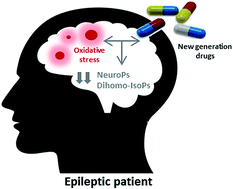Antiepileptic drugs affect lipid oxidative markers- neuroprostanes and F2-dihomo-isoprostanes- in patients with epilepsy: differences among first-, second-, and third-generation drugs by UHPLC-QqQ-MS/MS
Abstract
Metabolites of the non-enzymatic lipid peroxidation of polyunsaturated fatty acids (DHA, n-6DPA, and AdA), neuroprostanes (NeuroPs), and F2-dihomo-isoprostanes (F2-dihomo-IsoPs) have become important biomarkers for oxidative stress (OS) in neurodegenerative diseases, particularly in epilepsy. These biomarkers were measured by UHPLC-QqQ-MS/MS in the urine of 30 epileptic patients treated with different antiepileptic drugs (AEDs) (old treatment (n = 15) or new-generation treatments (n = 15)), in comparison with 15 healthy controls. After treatment with new-generation AEDs (levetiracetam, eslicarbazepine acetate, lacosamide, and zonisamide) a decrease was observed in the total urinary neuronal membrane degradation markers (NeuroPs) and neuromotor system degradation markers (F2-Dihomo-IsoPs), in comparison with the old treatment (carbamazepine, phenytoin, valproic acid) and control (no pharmacological treatment) groups. These results suggest that new-generation AEDs reduce the total NeuroPs/F2-Dihomo-IsoPs to levels similar to those of the control group and hence play an important role in antioxidant systems in epileptic patients. Unfortunately, little is known currently about the neuroprotective effect of second- and third-generation AEDs; so, more clinical studies need to be performed to clarify the relationships among chronic treatment with newer AEDs, oxidative stress, and epilepsy.


 Please wait while we load your content...
Please wait while we load your content...